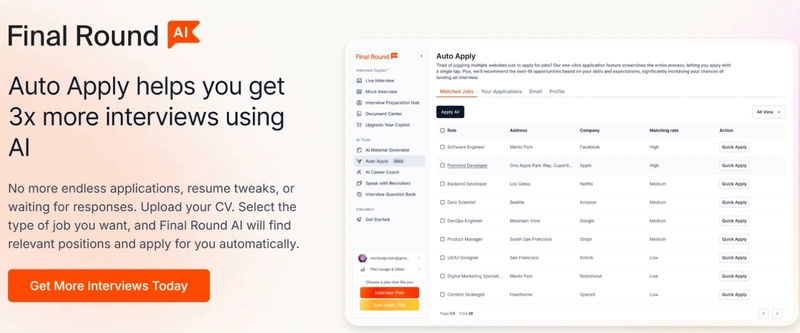Whether you’re tackling LeetCode, preparing for FAANG interviews, or just want to level up your problem-solving skills, mastering Data Structures and Algorithms (DSA) patterns is 🔑. Instead of memorizing 500+ problems, learning the core patterns helps you recognize solutions faster and build confidence. 💪🏻
Let’s dive in! 🔥
Top 30 DSA Patterns every developer should know
1. 🌀 Sliding Window
Used in problems like maximum sum subarray, longest substring without repeating characters, or minimum window substring, this pattern helps you dynamically maintain a window over the input (usually arrays or strings) while optimizing for performance.
Why it matters:
Sliding window turns what could be brute-force O(n²) solutions into efficient O(n) ones. It teaches you to think dynamically, focusing only on what's relevant inside the current window. Mastering this is a cheat code for string and subarray problems.
2. 2️⃣ Two Pointers
You’ll see this when solving 3Sum, sorted array intersection, remove duplicates, or even container with most water. It usually involves scanning from both ends of a sorted input.
Why it matters:
This pattern optimizes time and space by reducing unnecessary comparisons. It pushes you to write elegant, readable code, and is frequently tested in interviews to evaluate your grasp of pointer logic and array manipulation.
3. 🐢 Fast & Slow Pointers
Common in questions like detecting cycles in a linked list (Floyd's algorithm), finding the middle node, or Happy Number problems.
Why it matters:
It’s a clever pattern that avoids extra space while identifying cycles and intersections. It helps interviewers assess if you can spot hidden loops or understand pointer behavior over iterations.
4. 🌍 Merge Intervals
This pattern shines in problems like merging meeting schedules, inserting intervals, or finding common time slots.
Why it matters:
It tests your understanding of sorting and overlap logic. Merging intervals is more than just arrays, it's about identifying relationships and boundaries, making it a pattern that's popular in scheduling and real-life systems.
5. 🔎 Binary Search
Use it to solve problems like search in rotated array, find element in sorted matrix, or minimum in rotated array.
Why it matters:
Binary search isn't just about finding an element, it's a base for solving many advanced algorithmic problems. It demonstrates your ability to think in logarithmic steps and manage edge cases confidently.

Try Final Round AI for FREE today! 🔥
6. 🧮 Prefix Sum
Helpful for problems like range sum queries, subarrays equal to K, or finding equilibrium index.
Why it matters:
Prefix sum teaches optimization via pre-computation. It’s key to solving problems efficiently without looping multiple times over the same data, an essential performance trick.
7. 🧠 Dynamic Programming (1D)
Used in classics like Climbing Stairs, Fibonacci, and House Robber, anywhere there's recursion and memoization.
Why it matters:
DP is the holy grail of problem-solving. It shows you can break down problems into subproblems and build bottom-up solutions. Mastering 1D DP is the first step to more complex variations.
8. ⛓ Dynamic Programming (2D / Grid)
Appears in Unique Paths, Edit Distance, Longest Common Subsequence, and other matrix-based challenges.
Why it matters:
2D DP evaluates your understanding of multi-dimensional state transitions. It prepares you for real-world challenges where multiple dimensions affect the outcome, think games, maps, and logistics.
9. 🏛️ Topological Sort
Solves Course Schedule, Build Order, and Alien Dictionary.
Why it matters:
Topological sort is a foundational concept in dependency resolution. It shows your understanding of directed acyclic graphs (DAGs), a concept seen in compilers, project planning, and more.
10. 🌊 Breadth-First Search (BFS)
Used in shortest path, Word Ladder, or level order traversal of trees.
Why it matters:
BFS is perfect when you're searching layer by layer. It demonstrates how you handle queue-based logic, which is common in networking, AI, and maze traversal.
11. 🧗 Depth-First Search (DFS)
Great for problems like Number of Islands, Maze Solvers, and Graph Traversal.
Why it matters:
DFS explores paths deeply before backtracking. It teaches recursion, graph exploration, and component detection. Knowing when to use DFS over BFS shows maturity in algorithm choice.
12. 🔗 Linked List Manipulation
Examples include reversing a list, detecting cycles, and merging sorted lists.
Why it matters:
A classic test of your understanding of pointers and memory. These problems also teach you to write robust, bug-free code with constant space.
13. 🧱 Union-Find (Disjoint Set)
Useful in Connected Components, Graph Valid Tree, and Accounts Merge.
Why it matters:
It’s a powerful structure for understanding connectivity and networks. Interviewers love this pattern because it combines logic, optimization (with path compression), and problem modeling.
14. ⏪ Backtracking
Think N-Queens, Sudoku Solver, or Permutations.
Why it matters:
Backtracking is your go-to when trying every possible option under constraints. It highlights whether you can build recursion trees and apply pruning effectively.
15. 📈 Kadane’s Algorithm
Used to find maximum subarray sum, including circular variants.
Why it matters:
A masterclass in turning nested loops into linear time solutions. Understanding Kadane’s proves you can optimize greedy behavior dynamically.
16. 📊 Monotonic Stack
Used in problems like Largest Rectangle in Histogram, Next Greater Element, and Daily Temperatures.
Why it matters:
One of the trickiest but most rewarding patterns. Mastering it shows your depth in stack-based thinking and ability to solve real-time window problems.
17. 🧬 Trie (Prefix Tree)
Great for autocomplete, search suggestions, or word dictionaries.
Why it matters:
Tries are crucial for problems involving prefix search. They demonstrate your understanding of tree structures and efficient string indexing.
18. 📉 Heap / Priority Queue
Used in Top K elements, Median Finder, or Dijkstra’s algorithm.
Why it matters:
Understanding heaps lets you prioritize processing efficiently. You’ll need it in any situation with dynamic sorting, task management, or stream processing.
19. 🔢 Bit Manipulation
Helpful in problems like Single Number, Count Set Bits, or Power of Two.
Why it matters:
These problems test low-level thinking. Bit manipulation is ultra-efficient and often used in space-constrained, performance-critical applications.
20. 🧭 Matrix Traversal
Use it in Spiral Matrix, Flood Fill, and Word Search.
Why it matters:
A must-know pattern for navigating 2D data. Mastering traversal with direction vectors and visited tracking helps in image processing, maps, and simulations.
21. 🧪 Counting Patterns
Appears in Good Triplets, Counting Pairs, and Anagram Grouping.
Why it matters:
Teaches combinatorics and hash-based grouping. Often tested to assess how well you can track frequency, use hash maps, and reason in counts.
22. 🎰 Bucket Sort / Counting Sort
Used in Top K Frequent Elements, Sort Colors, or Frequency Sorting.
Why it matters:
Helps sort data efficiently when the range is known. Also demonstrates understanding of time-space trade-offs.
23. 🌳 Recursion Trees
Used in subset problems, backtracking, and divide & conquer strategies.
Why it matters:
Understanding recursion tree patterns makes it easier to analyze time complexity and build elegant recursive solutions.
24. 📦 Stack + Queue Hybrid
Seen in problems like Implement Queue using Stack, Evaluate Expressions, or Min Stack.
Why it matters:
Tests your data structure creativity. Being able to simulate one structure using another shows a deep conceptual understanding.
25. 🗺 Graph Traversals with Weights
Use this in Dijkstra’s, A Search*, and Minimum Spanning Tree problems.
Why it matters:
This pushes your knowledge of graph theory, algorithms, and real-world routing applications. Crucial for network-heavy problems.
26. 🧩 Matrix DP
Appears in Minimum Path Sum, Unique Paths with Obstacles, and Coin Change II.
Why it matters:
Combines dynamic programming and grid traversal. These types of questions showcase your ability to cache state across 2D space and build modular logic.
27. ⚖ Pattern Matching
Used in KMP Algorithm, Rabin-Karp, and Wildcard Matching.
Why it matters:
Shows knowledge of string searching and hashing. Efficient string pattern matching is important in compilers, search engines, and NLP.
28. 🌴 Segment Trees
Solves range query problems, like sum/range max, or lazy propagation tasks.
Why it matters:
If you’re aiming for high-performance data queries, segment trees are essential. This pattern demonstrates your algorithmic depth and optimization skills.
29. 📖 Sliding Window + Hashing
Appears in Minimum Window Substring, Anagram Checking, and Longest Repeating Substring.
Why it matters:
Combining two patterns shows you can compose algorithms smartly. This is crucial for writing efficient, scalable solutions.
30. 🔄 In-place Transformations
Used in rotate matrix, reverse words in place, or flatten binary tree.
Why it matters:
These problems test memory discipline. They show whether you can optimize space without sacrificing clarity or correctness.
🎉 Final Thoughts
Learning DSA isn’t about memorizing hundreds of problems. It’s about recognizing patterns 🧠. By learning these 30 DSA patterns, you're not just preparing for interviews, you're learning how to think like a problem-solver.
Master patterns, not problems, because interviews may change, but great thinking never goes out of style. 🔥
| Thanks for reading! 🙏🏻 Please follow Final Round AI for more 🧡 |
|---|









Top comments (10)
What an amazing article...!
These 30 DSA patterns are explained so well and are absolutely essential for any developer looking to level up their skills or prepare for interviews.
Thank you for this valuable content...! 👏
Thank you so much for your kind words! 🙏🏻 I'm really glad you found the article valuable. These patterns truly make a huge difference in interviews and real-world problem solving, so it means a lot that it resonated with you.
Wishing you the best on your DSA journey.
Helpful list. Do you have any sources to practice these patterns?
Thank you so much! 🙏🏻
Great question! Yes, I recommend practicing these patterns on platforms like LeetCode, HackerRank, and Codeforces. You can search by pattern or specific problem tags.
Thank you so much for sharing this amazing list 🙏 It's very helpful 🔥
You're welcome 🙏🏻 I'm glad you found it helpful
Thanks @hadil keep up the good work
Thank you so much for your encouragement Mark 🙏🏻🙏🏻
Nice list. Thank you so much!
You're welcome 🙏🏻🙏🏻
Some comments may only be visible to logged-in visitors. Sign in to view all comments.